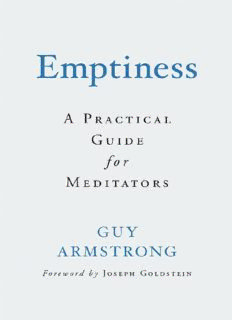Table Of Content“For anyone seeking to understand emptiness, this is a clear and fine guidebook, with precise and practical
ways to explore and deepen your practice.”
— Jack Kornfield, author of
A Path with Heart
“Emptiness is a brilliant and practical introduction to the practice and attainment of liberation.
Encapsulating Guy Armstrong’s decades of dedicated Buddhist practice and study, Emptiness presents
profound Buddhist teachings and describes ways practitioners can experience them for themselves. This is
an important foundation for anyone interested in the meditation practices of Buddhism.”
— Gil Fronsdal, author of
The Buddha before Buddhism
To the teachers who kindly pointed me toward emptiness: Joseph Goldstein,
Tsoknyi Rinpoche, Christopher Titmuss, and of course Gotama Buddha
You should train yourselves thus: “When those discourses spoken by the Tathāgata that are deep, deep in
meaning, supramundane, dealing with emptiness, are being recited, we will be eager to listen to them, will
lend an ear to them, will apply our minds to understand them; and we will think those teachings should be
studied and mastered.” Thus should you train yourselves.
— The Buddha, Samyutta Nikāya 20:7
CONTENTS
Foreword by Joseph Goldstein
Preface
Introduction
PART I: SELF
1.The World Is Empty of Self
2.The Faulty Logic of “I”
3.What Is Real?
4.The Five Aggregates Are Not Self
5.Creating a Self
6.When the Aggregates Fall Apart
7.Beyond Self
8.Bearing Emptiness
9.Karma: Patterns of Becoming
10.Who Is Reborn?
11.The End of Karma
12.Abiding in Emptiness
13.Cessation and Nibbāna
PART II: PHENOMENA
14.A Lump of Foam
15.The Magic Show
16.The Middle Way
PART III: AWARENESS
17.The Nature of Awareness
18.Womb of the Buddhas
19.Sunlight in Empty Space
20.Aware of Awareness
PART IV: COMPASSION
21.Compassion Comes from Emptiness
Acknowledgments
Sources and Abbreviations
Notes
Glossary of Pali and Sanskrit Words
Index
About the Author
FOREWORD
IN THIS REMARKABLE BOOK, Guy Armstrong guides the reader through the
foundational realizations necessary to explore the profound truth of emptiness
and the increasingly subtle understandings of its deeper meanings.
For thousands of years, different Buddhist schools have highlighted aspects
of the path to freedom, each reflecting the liberating insights of its own
particular tradition — and from time to time, there have been great masters who
have seen what is held in common by many of these schools and woven together
paths of practice that integrate elements from each of them. Guy’s eminently
practical and deeply investigative work follows in this nonsectarian tradition,
weaving together teachings from the Pali Canon, the writings of Chinese and
Japanese Zen masters, and the great Tibetan lineage-holders. He does this so
skillfully that in the very reading of the book we are led to a more
comprehensive understanding of the path and the various skillful means needed
for its fruition.
What makes this book so user-friendly is its nondogmatic presentation of
views. While referencing different points of controversy among the various
Buddhist schools, Guy’s approach remains pragmatic: How do these teachings
help to liberate the mind? With this wonderfully clear book he invites us to
consider and practice different approaches, all of which lead to our own
deepening and freeing realization of the nature of awareness and its intrinsic
emptiness — and to the manifestation of compassion in our lives.
Joseph Goldstein
PREFACE
The world is full of obvious things which nobody by chance ever observes.
— Sherlock Holmes
Truth lives all around me but it’s just beyond my grasp.
— Country Joe McDonald
I’VE ALWAYS LIKED A GOOD MYSTERY. From Sherlock Holmes to John le Carré,
I’ve been fascinated by the idea that there’s more going on than meets the eye. In
college I majored in physics, because I loved the way science reveals things that
are hidden from ordinary view. In grad school I studied computers to find out
how machines could do such amazing things. Psychology was always an
interest, because the mind, too, is a vast, unknown land. In all these disciplines, I
discovered that close observation, pointed questions, and sustained reflection
were the keys to unlock the gates.
When I stumbled onto Buddhism, I was delighted to find a whole new set
of mysteries to explore. From the age of twenty-eight, I began to dedicate my
life to learning what I could from teachers and meditation, including a year in
Asia as a Buddhist monk. Many of the teachings I encountered made good
common sense, and I was grateful for their emphasis on wise choices in speech
and action. Meditation was a marvel that brought me a measure of calm, but my
conceptual mind was most intrigued by things I couldn’t quite understand, like
not-self, enlightenment, nirvana, and emptiness. It seemed that comprehending
these subjects must be necessary to realize the path of transformation and
freedom, but however much I thought about them in the beginning, I couldn’t
penetrate them. Still, the glimmerings of these mysteries inspired me, and I was
determined to explore them further. After some years, I began to teach what I
had learned, primarily through leading silent retreats in the Insight meditation
tradition.
The word mysteries has long had religious connotations. In both ancient and
modern cultures, there have always been priests and priestesses, nuns, monks,
and shamans seeking to learn from the mysteries and thereby shift their
relationship to themselves and others, to life and to death. This book is intended
Description:If everything is empty, then what ceases in Nirvana and is born in rebirth? How can you live in the world without feeling trapped by it? Guy Armstrong tackles these questions and more in this richly informed, practical guide to emptiness for the meditator.It may seem odd for emptiness to serve as

